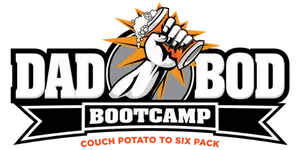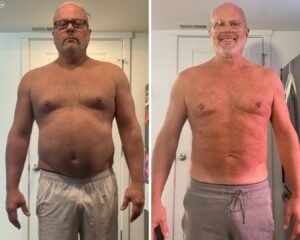Beer belly, spare tire, and love handles. In the old days, those unflattering terms were how people would describe gentlemen with a particular body shape. But in recent years, a new moniker has superseded them: the dad bod.
Odds are you can list off a few dad bod examples. The bumbling father figure on any sitcom post-Married With Children tends to fit the bill. But despite being fashionable at the moment, are dad bods all they’re cracked up to be?
To get to the bottom of it, let’s first define what a dad bod even is and take a look at what your figure says about your health.
What Is a Dad Bod?
The phrase “dad bod” entered the pop-culture lexicon back in 2015. The term is attributed to 19-year-old college student Mackenzie Pearson, though she clarifies that it was already something that she’d heard tossed around campus. Whoever first coined the phrase, it describes the kind of beer-swilling frat boys built like middle-aged men you see all over college quads.
Someone with a dad bod isn’t obese. They even tend to sport a bit of muscle, particularly in the arms.
As Pearson described it, someone with a dad bod looks like he might hit the gym a couple of times a week. But between gym sets, he’s all about Taco Tuesdays and cracking open a few cold ones.
So if you met a stranger with a dad bod, you might guess that he had been a high school football star 20 years ago. Although seeing as many of these men are only in their 20s to begin with, that’s not necessarily a good thing.
Muscle isn’t a requirement, however. The only core criterion is belly fat. We’re talking waistbands of 40 inches and up. To see what that looks like in practice, let’s check out some high-profile examples.
Dad Bod Examples
One of the best, early examples of a dad bod in the media was John Hamm as Don Draper in Mad Men. Now the character might not be the first thing you think of as he doesn’t look pudgy in most of his scenes. But that’s more of a testament to what a tailored suit can do for a man’s figure than anything else.
Take a look at any scene where he’s shirtless, however, and boom: dad bod on deck. While less pronounced than some examples, he’s noticeably soft around the midsection with sagging pecs.
Arguably, Don Draper is truth-in-television. A middle-aged, alcoholic ad executive in the 1960s probably shouldn’t have a rippling physique, realistically. But you might question whether that’s a pattern you want to imitate.
Closer to what most people imagine a dad bod to look like is Seth Rogan. Again, while he’s overweight, he’s not nearly obese. He makes for a great everyman underdog because he looks a lot like how we imagine a regular guy in his late 30s to early 40s should look.
Chris Pratt, back in his days on Parks and Rec, was another popular example around the time dad bods became popular. At his heaviest, he weighed in at around 290 pounds, making him probably the most overweight example on this list. All the same, dad bod fans mourned his weight loss when he got shredded for his roles in Guardians of the Galaxy and Jurassic World.
What a Dad Bod Says About Your Health
While some may love the dad bod for one reason or another, walking around with one doesn’t come without risks.
As we noted earlier, the defining characteristic of a dad bod is having a belly. However, the kind of fat that contributes to the dad bod gut can pose a particular slate of health risks.
This is because the main type of fat you find in the belly is what’s called visceral fat. This type of fat is found deeper in the belly, underneath the abdominal muscles around the internal organs. This type of fat secretes lipids and hormones that can wreak havoc throughout the body.
Excess belly fat is one of the key predictors of type 2 diabetes, for example. Besides being a life-changing disease in its own right, type 2 diabetes tends to increase a person’s chances of suffering a heart attack or stroke.
An excess of visceral fat is also associated with an increased risk of cardiovascular disease. And in high enough amounts, visceral fat can even penetrate the liver, causing fatty liver disease. Not ideal, considering how many men get their dad bods from enjoying their beer a little too much.
But it would be bad enough if having a dad bod only impacted a man’s health. In reality, though, it can also impact the health of his children.
What Happens When a Father-to-Be Has a Dad Bod
A contributing factor to men developing dad bods is the fact that they tend to become less active in their late 20s and early 30s. And this trend just so happens to coincide with the age most men start families.
And that’s bad news because being overweight can hamper your ability to have children. According to one study, heavyset men are 11% more likely to have low sperm counts. The more overweight a man is, the worse the effect tends to be.
A reduced ability to have children would be reason enough for prospective dads to look into shedding some weight. But even if you can have kids, a dad being overweight can put the little tykes at risk of health problems.
Research now suggests that being overweight affects the genetic information a man’s sperm carries. These genetic markers have the potential to affect brain development and reduce appetite control. The result: children who are genetically predisposed to overeating and weight gain, setting them up for lifelong health risks.
Shedding that Dad Gut
This body type might be in vogue right now, with famous dad bod examples finding their way onto magazine covers and clickbait articles. But the thing about fads is that they always fade. And when this one passes, all these dad bod owners will be left with is wrecked health that can go on to affect younger generations.
But it’s never too late to trim that waistline. To get started, check out how our Dad Bod Bootcamp can shred those extra pounds while honing the muscular body hiding underneath.






0 Comments